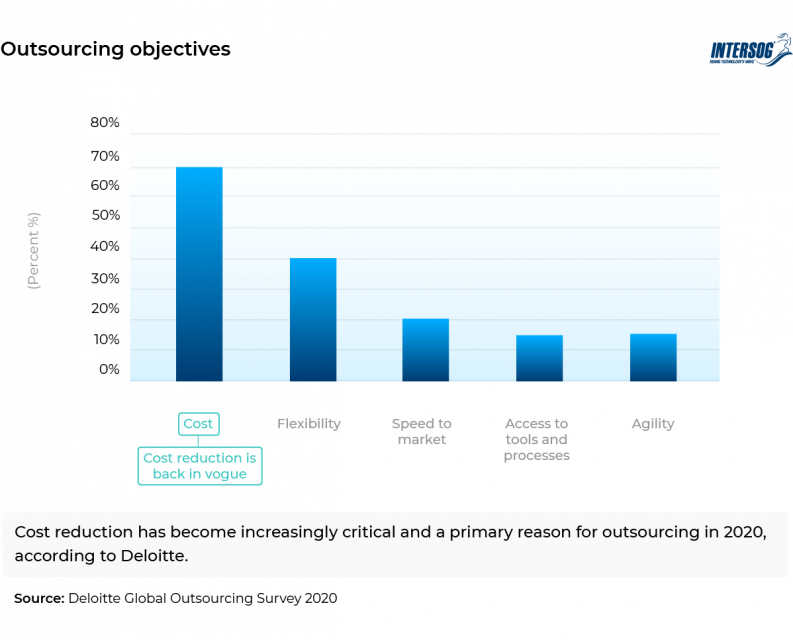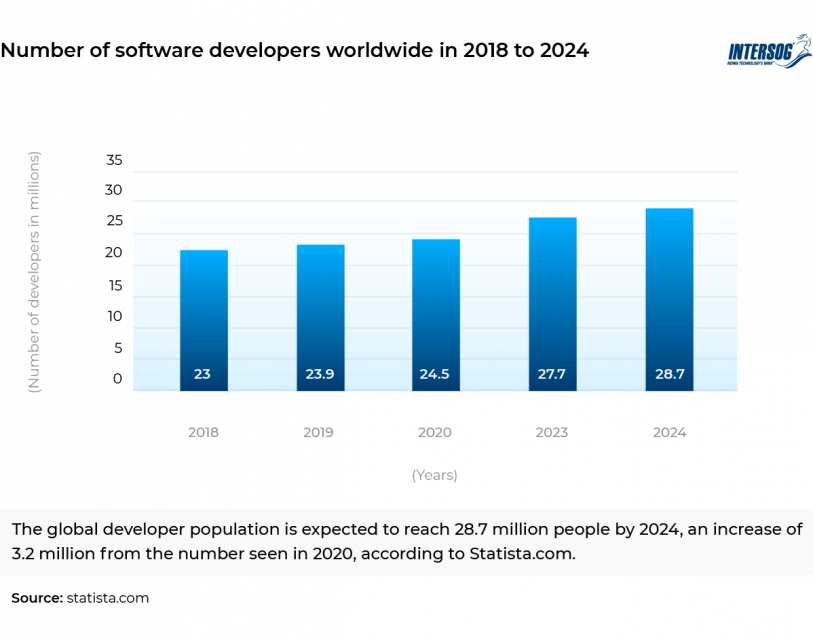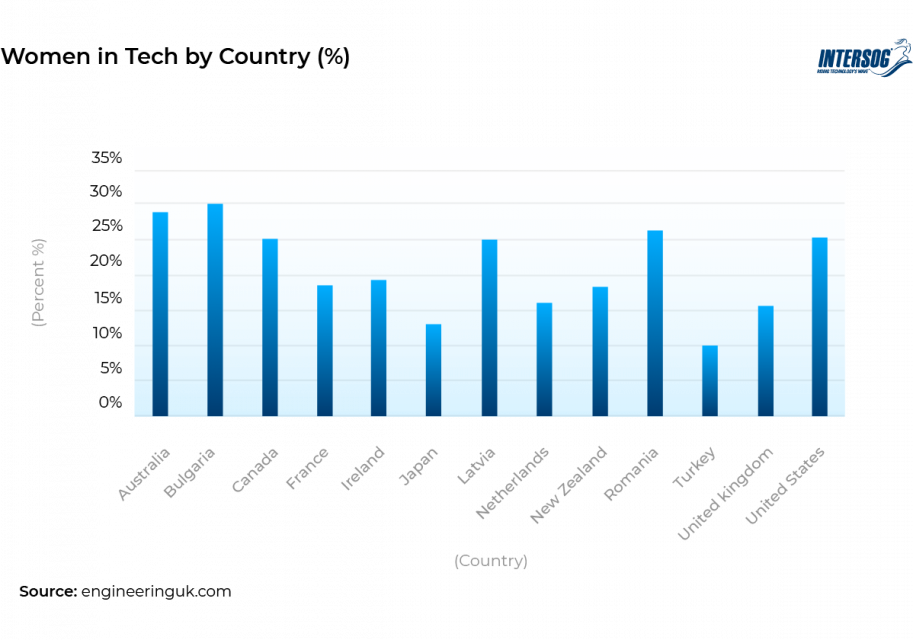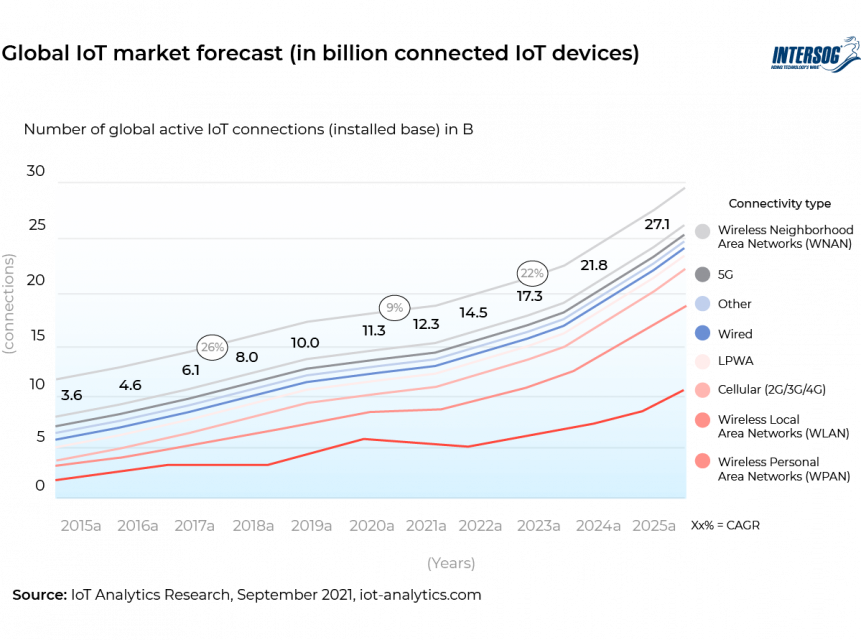Software development outsourcing is a dynamic market that evolves with every following year responding to global events and business trends. Not unlike the previous year, 2021 has been in many ways defined by the pandemic and its impact upon the industries and businesses around the world. The growing role of the remote workforce and the increasing demand for cost-efficient software development are the main factors driving the IT outsourcing market throughout 2020 and 2021.
The year-over-year growth rate for the market between 2021 and 2024 is estimated at around 3 to 5%. As of 2020, the value of the global IT outsourcing market is estimated to be around $92.5 billion, which is impressive but still not the highest the industry has even been. In fact, the fluctuations in the size of the market are quite natural and happen every year. For the past 5 years, the market has been on the rise from $88.9 billion in 2015 to the projected 98 billion in 2024.
That is not all the outsourcing software development statistics we have for you since there are many more exciting trends shaping the market at all times.
The Demand-Supply Gap is Growing
As projected by the US Bureau of Labor, the demand for software developers, testers, and QA experts will grow by 22% between 2020 and 2030 making them the fastest-growing occupations in the country. As of 2020, there were 1,847,900 jobs in these three occupations in the US, and with a projected growth rate, there will be 409,500 more by 2030.
Meanwhile, the top higher educational institutions in the US only grant around 3,600 degrees in Computer Software Engineering. This creates a huge gap between the demand and supply of software developers in the US. Throw in a couple of thousands of self-taught developers each year, and you still have dozens of thousands of jobs to fill.
The tech talent crisis is already upon us, and it will only get worse because there simply aren’t enough people. With more than 189,000 jobs opening each year, there’s simply no way to cover that demand with domestic human resources. The staggering software developer job statistics show exactly how bad the gap is, which leaves outsourcing as the only viable option to cover the growing demand.
The apparent lack of software engineers in the US cannot be satisfied by the domestic talent pool just yet. If the trend does not shift, outsourcing will remain a go-to solution for most companies in the domain.
70% of Companies Choose Outsourcing for Cost-Reduction
According to the 2020 study by Deloitte, 70% of companies who choose to outsource their software development projects, do so to save money. In the previous years, the same studies have shown that cost reduction has been viewed as an important but not the main reason why tech companies would choose to outsource.

In 2020, as well as 2021, cost-efficiency is the top reason to outsource projects because of the tumultuous global events and the economic recession caused by the pandemic. It is reasonable to assume that this trend in the software development industry statistics will persist in 2022.
Outsourcing your project overseas might be your best idea if your main goal is to reduce the cost of that project.
This is especially true if you outsource to a developing country, which is why countries like India have become so popular within the previous decade. However, India is not the only place to ship your development to.
It makes sense for US-based companies to outsource their projects to developing countries nearby. Mexico, Argentine, Chile, and Columbia are the perfect fits here.
These countries are located nearby, which means they fall in the same time zones as the US.
The most important benefit here is that the median income across those countries is considerably lower than that in the US.
This also touches software developers who operate at much lower hourly rates.
The same goes for many Central and Eastern European countries, especially Ukraine. This is one of the top outsourcing destinations in Europe thanks to its vast talent pool, low hourly rates, and consistent quality across the board.
With more than 240,000 developers in the country, Ukraine is one of the biggest European talent pools and arguably the best one when it comes to quality and hourly rates.
Canada, though a well-developed country itself, is also a rather cost-efficient destination for most US companies out there.
Geographic and cultural proximity makes it one of the best outsourcing destinations, and though a cost-saving aspect is not as prominent here, you can still get a good bang for your buck.
Asian developers, namely in India and Vietnam are also quite popular among the US companies who seek to outsource their projects and save money.
There, you can count on even lower prices but it comes with certain caveats.
One of the bigger problems here is the time gap between the US and Asian countries. Most of the time, your developers would work while you sleep and vice versa, which is not optimal for project coordination.
Nearly 300,000 Jobs are Outsourced out of the US
A vast number of jobs are being sent overseas due to different reasons. Cost-reduction and the shallow domestic talent pool are the main reasons why many American companies choose to outsource their projects.
Custom software development companies around the world are fully aware of the IT talent shortage in the US and other countries.
Software development companies try to capitalize on that crisis by hoarding up local developers and partnering with US companies for their projects. This is a rather straightforward approach that has shown a huge value for both the US companies who outsource their projects and the overseas developers who get the opportunity to make good money by working with the US clients.
The growing demand for software developers stimulates the global increase in the number of IT professionals and the number of companies that provide such services all over the globe. It is estimated that there are some 24.5 million software developers in the world and this number is expected to grow by more than 4 million by 2024.

Much of this growth will occur in Asia, namely in China, with the LATAM region following closely. For instance, there are approximately half a million developers in Brazil alone, an additional 240,000 in Mexico, and some 100,000 in Argentina. Add countries like Chile, Columbia, and other LATAM countries, and you have a solid million developers right at your doorstep.
Central and Eastern Europe are not lagging behind either with roughly 1 million developers concentrated in countries like Ukraine, Poland, Latvia, and Lithuania. Ukraine alone harbors more than 240,000 developers. Add immense cost-reduction opportunities on top of that, and you get yourself an immense talent pool of expert software developers for your project at a low hourly rate.
Gender Representation in Tech
According to the data from Wise, women make up just around 16% of the workforce in the IT sector globally. This proportion corresponds to the number of women who pursue degrees in software engineering – exactly 16%. Unfortunately, the data here is sparse, but judging from the report by EngineeringUK, this trend might shift somewhat in the next decade. Young women aged between 16 to 19 seem to become more interested in pursuing STEM careers, though young men would still grow to constitute a considerable majority of the workforce in the industry.

According to EngineeringUK, there’s a gap of around 21 to 24% between young men and women interested in engineering careers. One should understand that being interested does not mean they would actively pursue such careers in the future, though. This leaves us with a conclusion that a gender gap in software engineering would not be bridged in the nearest future. This is simply because there are more men pursuing such opportunities than there are women.
Massive Employment Opportunities
Outsourcing creates millions of jobs around the world. With the US alone outsourcing a massive number of jobs overseas, developing countries that amass the most labor force in the IT domain gain a huge economic boost.
Take LATAM countries as one of the better examples here: outsourcing creates roughly 1,000,000 jobs across the region, which provides local experts with some substantial money-making opportunities. Even with a much lower rate per hour compared to the US-based developers, LATAM developers can make a solid buck by working with American clients.
The same goes for the developers in Asia and Central and Eastern Europe. The median income in these regions is considerably lower than that in the US, but qualified IT experts can make above-average money while still being a cost-efficient option for their US clients. Not only does this trend improve the personal wealth of the developers, but it also boosts the economic growth of developing countries across the globe.

Edge Computing is Growing Popular
As the number of Internet of Things devices increases, edge computing technologies are growing more popular. According to IoT Analytics, the number of IoT devices grows continuously with more than 12.3 billion IoT devices worldwide in 2021, which is 9% more than in the previous year.

The current state of the IoT sector, as well as its progression over the past 5 years, suggests that the number of connected devices will only grow in the future. What does it have to do with the software development statistics though? Well, it means that a larger number of custom software development companies will shift their gears towards this prospective domain.
Companies Go Agile
According to Harvard Business Review, the majority of businesses are keenly aware of the benefits of Agile yet most of them fail to truly implement its principles in their operations. At the same time, those who have successfully implemented Agile throughout their organizations have seen up to a 60% increase in revenue.
However, only 18% of the surveyed companies turned out to be the real Agility Masters, which means that agile practices are not that easy to implement.
Apart from the higher revenue, Agility Masters are 4.1 times more likely to develop the right and homogenous strategy for the project and 2.3 times more likely to take risks. Also, they are 2.9 times more likely to have teams of experts proficient in the use of the latest tools and trends.
Oftentimes, the teams of such skilled experts come from the outside, as the Agile companies are more likely to cooperate with outsourced developers. Basically, Agility Masters are more comfortable taking risks or using unconventional approaches to their software development projects.
Outsourced IT and development teams will, thus, play a critical role in creating truly agile businesses. Though truly agile companies are still rare, their portion will increase as more and more businesses explore the apparent advantages of agile.
Final Thoughts
The main takeaways here are:
- Outsourcings is becoming more popular;
- New destinations like LATAM and Central Europe are growing more popular;
- Cost-Reduction is the main reason why companies choose to outsource;
- The number of jobs outsourced from the US is not going to dwindle;
- Women are still going to be a minority in software engineering;
- IoT is the next big thing in tech;
- More companies will pursue the agile approach.
Offshore software development is growing more popular, especially in the light of the global events reshaping markets and industries. The main reason behind the positive offshore software development statistics is the fact that it is simply cheaper to outsource your project rather than go through the exhausting recruitment process and try to hire people on your own.
The situation is further escalated by the IT talent crisis. It is much harder to hire people on your own, it takes too much time, and it is too expensive. Additionally, if anything goes wrong, the failure cost would be much greater.






